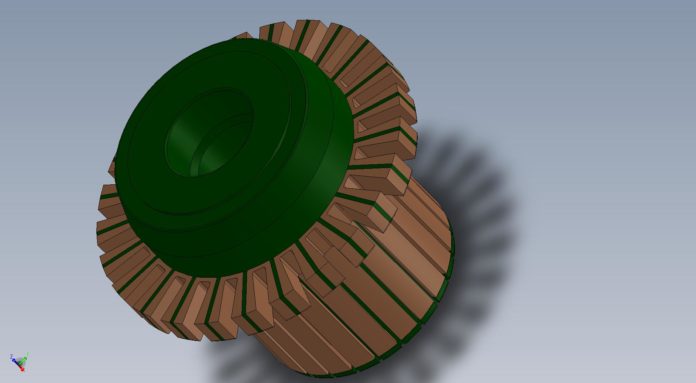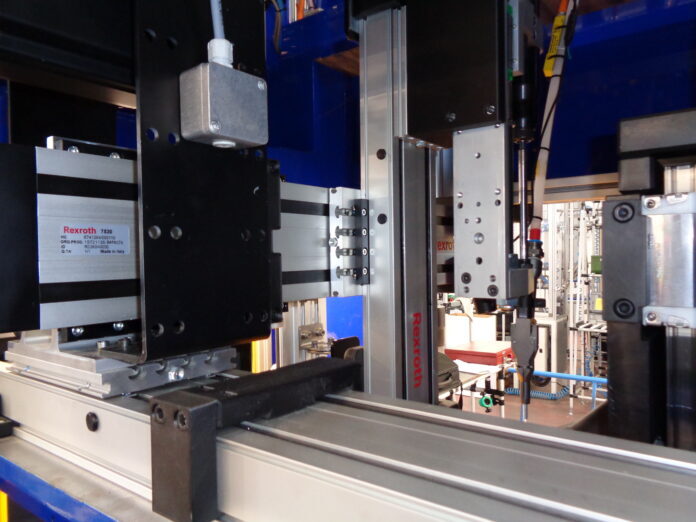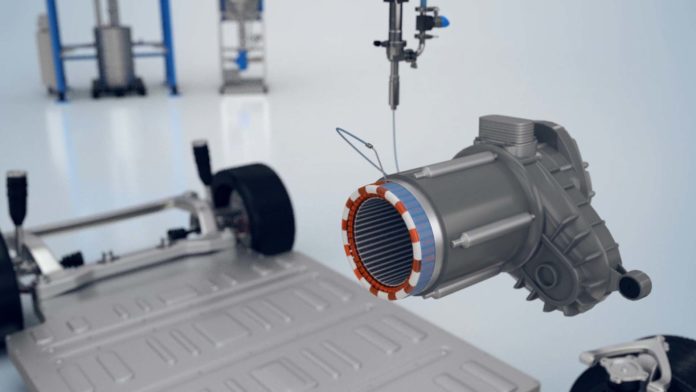A rising number of OEM and manufacturers is assessing various winding processes. Among them, there is the stator wave winding technology that allows manufacturing more compact, lighter and more performing electric motors. Thanks to higher voltages (> 800 Volt) combined with silicon carbide inverters to reach higher switching speeds, designers are looking for other ways to obtain a constant improvement of the electric powertrain group.
The wave winding process is apt for increasing the filling factor of slots, keeping the copper losses linked with the frequency under control. Rectangular conductors, in fact, even reducing the copper losses in direct current through the wider section for the current passage, suffer from bigger proximity and skin-effect losses that are counterposed to the advantages brought by the bigger copper section versus round conductors, especially at higher frequencies and speeds. A design method to reduce undesired effects notably, only slightly reducing the filling factor, consists in increasing the number of rectangular conductors per slot. In the last decade, we have witnessed a clear trend, increasing the typical number of conductors per slot from 4 to 6 and, more recently, to 8. One of the main challenges in the increase of the number of conductors per slot is the number of weld points that would be necessary for a conventional winding type. Weld points add complexity to the process and they are not ideal in terms of both mechanical reliability and of electric conductivity. Therefore, the wave winding, avoiding the need of welding in several points, allows a bigger quantity of rectangular conductors per slot.
«The designers of electric motors seem to have found an ideal condition with 8 conductors per slot, allowing well-balanced losses in direct current and frequency-related, increasing the efficiency and the power density. For those who are acquainted with the wave winding process it is clear that, besides the advantages in terms of electric motor performances, the various manufacturing phases are particularly demanding for the insulating coating of the magnetic wire, in terms of both ductility and resistance and compression requisites. Here our Ketaspire® Peel comes into play: ductility and toughness at the top of the range allow achieving thin insulating layers even in the harshest work conditions. This is one of the ways in which Syensqo product portfolio for electric motors enables this innovative winding process», Syensqo explained.
Syensqo for the stator wave winding
European début for MG4 Electric
The new MG4 Electric, full electric model by the historical automotive British company MG, is incoming on the market. Engineered on MSP “Modular Scalable Platform” it will be proposed with both rear and all-wheel drive and the three different trim levels, standard, comfort and luxury.
The standard is equipped with 51 kWh battery and rear 125 kW electric motor with 250 Nm of torque, a configuration that allows an acceleration from 0 to 100 km/h in 7.7 seconds, a maximum speed of 160 km/h and autonomy up to 350 km in WLTP cycle. The battery can be recharged in direct current up to a power of 117 kW. In alternate current up to 6.6 kW.
On the other superior set-ups, then comfort and luxury, the 64-kWh battery is offered and a rear electric 150-kW motor with 250 Nm of torque. The maximum speed is always 160 km/h, whereas it takes 7.9 seconds to accelerate from 0 to 100 km/h. The maximum autonomy is equal to 450 km (435 km for Luxury). In direct current, the battery can recharge up to a maximum power of 135 kW. In alternate current, instead, up to 11 kW.
In the future, MG4 is likely to be available also in more sportif version with double motor, all-wheel drive and approximate 400 HP power.
Solaredge releases on the market bi-directional battery chargers for electric vehicles
The sale of the first models is expected by the second half of 2024.
The Israeli manufacturer of inverters and batteries SolarEdge has unveiled a bi-directional DC-coupled electric vehicle charger for electric motors. The DC-coupled architecture of the device allows the simultaneous charging of electric vehicles directly from photovoltaic systems, from residential batteries and from the grid.
The battery charger is connected with a single-phase or three-phase inverter by a DC bus circuit that can be oversized up to 200%, permitting to recharge the electric vehicle with the photovoltaic energy in excess. The battery charger has a charge/discharge speed of 12/24 kW and a DC to DC 99% peak efficiency. The sizes of the device are 620 mm x 340 mm x 200 mm, it weighs 22 kg and is provided with a 7-metre cable. It can operate at temperatures included between -30 C and 50 C is equipped with an envelope classified IP-65 for internal and external use.
V2G applications allow automatically charging and discharging electric vehicles’ battery according to the dynamic prices of utilities. This permits house owners to receive payments by their electricity provider by discharging the energy of electric vehicles’ battery stored in the net during events of response to the demand.
Moreover, users can use the electric vehicle’s battery to carry out the backup of their dwellings when the vehicle is parked by using a V2H application. The battery has a maximum capacity of 50 kWh.
“The battery charger will be compatible with both powertrains for electric vehicles featuring 400 V and 800 V through a CSS standard connector”, stated Solar Edge in a note.
A new technology implementing electric head commutators

Reference partner in the production of hook-type electric commutators for A.C. and D.C. motors, Cagnoni operates on the market with a very broad range of products (diameters starting from 15 up to 30 mm), suitable for small appliances, automatic door-opening systems, automotive, power-tools, and so on. Such products are implemented starting from a continuous element (copper tube of 5 m) exploiting a unique up-to-date technology, which provides for obtaining the internal grips of the commutator bars from that part of semi-finished product that would be then removed by the successive milling phase.
In that way, no copper is added to create the gripping itself.
That process, developed by Osimo (AN) company itself, will enable a minor waste of raw materials, without affecting the product quality and granting total reliability and extreme flexibility to its customers.
Concerning the sector of electric head commutators, the last decade has been characterized by more and more articulated and interacting competitive factors, summarized in the following points: reduction of sale prices, decrease of component costs, rise of the contents and of the performances of electric motors, increase of the reliability and duration demands.
The offer excess compared to the demand, together with the appearance of unbranded products on the market and, especially, of big low cost producers, have determined a price fall and a standardization “towards the middle” of the functional characteristics of products. In this context, the sector companies’ challenge consists in enhancing the quality and the variety of the offered services by seizing, for instance, the potentialities made available by new technologies.
Increase performances and tear the costs down
The primary manufacturers of electric head commutators use a consolidated technology that provides for the assembly of copper bars (manufactured through cold drawing, successive parting-off and eventual removal of material in excess) around opportune positioning cages. Then they proceed to the moulding of the thermosetting resin to fix the position of bars, to the milling to create voids on the head, the undercutting to eliminate insulating material present between one bar and the other, to turning to achieve the final geometry and, finally, to finishing operations. A technology that certainly allows implementing components that feature good performances and quality but nevertheless, still today, affected by a series of problems and criticalities among which the main ones concern: the use of a big quantity of raw material (copper) connected with the fact that the piece geometry is obtained by stock removal.

The need of removing the insulating material from the sliding surface of the brush (undercutting) which implies quite long machining times, due to the particular product geometry (accentuated head overhang), it is necessary to use cutters with very small diameter (about Ø 10mm) that perform a very low feed speed (scarce product productivity).
Moreover, the undercutting needs a very precise cut positioning, with the result of calling for level electronics (tracking mode cutting) and of producing anyway a certain quantity of non-compliant products.
The inner gripping of the commutator bar, realized through a big T-shaped protuberance, it too of copper, which notably increases the mass to be held while rotating.
Dealing with the current above-described survey, it is therefore obvious that the development guidelines of the reference market precisely converge towards an ever-growing demand for new technologies, for increasingly performing products at low costs. Research and development, strongly pursued by Cagnoni itself, over the last few years was aimed at studying, experimenting and developing an alternative technology to the conventional ones used by competitors today.
Such technology, which provides for cold moulding (instead of the traditional stock removal machining), will permit to manufacture copper head commutators (therefore optimizing the use of raw materials) with better final characteristics, lower industrial costs than those applied on the market today and with both economic-productive and environmental benefits.
Therefore, the company’s R&D department intends to create a different product/process from the present state-of-the-art.
DANA spicer electrified e-Axle and e-Gearbox
Two new electric drive train solutions for off-highway vehicles, including the e-Axle and e-Gearbox, are recently introduced in the market by Dana. These technologies enable electrified propulsion by leveraging the company’s portfolio of motors, inverters, and controls.
Aziz Aghili, president of Dana off-highway drive and motion technologies, said: «Vehicle manufacturers in mining, construction and other off-highway markets are efficiently transitioning toward electrification, while retaining a large portion of their products in traditional technologies. Dana has positioned the company to be energy-source agnostic to support our customers across drivetrain configurations, including electrodynamic components that accelerate the adoption of electrification through the introduction of technologies specifically selected to meet the needs of current vehicle architectures».
The Spicer Electrified e-Axle combines Dana’s heavy axle design with a high-efficiency TM4 Sumo HP motor/generator and inverter combination for medium-sized mining trucks, medium-sized load haul dumpers, and large lift trucks.
Supplying 139 kW of continuous power and 193 kW at peak power, the TM4 motor/generator and inverter join together at the center housing of the axle. So to provide the right torque and efficiency within the usual space of an internal-combustion engine and transmission.
Ride Dc brush motors with permanent magnets
The Ride DC electric motors catalog divides into subcategories, identified by the external stator diameter, by the rotor length, in mm and by the presence of the Encoder.
In the subcategories there are different construction options. To support the choice of the best DC electric brushed motor, Ride shows interactive configurable data sheets.
Ride thinks in this way to the customers who need personalized DC electric motors, which can be anyway assembled trough consolidated and automatized processes, which guarantee competitive production costs and the reliability, indispensable in each application.
Between the offered permanent magnet DC motors, for each diameter it is possible to decide for the “standard” or for the “stronger” version: the difference comes from the rotor length. Longer is the rotor higher is the stall torque and the power that the DC brushed motor can reach. Among these products there is M77x40, stall torque from 5,10Nm to 1,27Nm, DC electric motors with brushes.
If requested, they can be equipped with EMC filter, usually made by two inductances and two capacitors.
In the inteactive technical datasheet it is possible to configurate the electric motor by selecting the preferred between the availabel options: motor shaft, filter, characteristic curve.
The interactive characteristic curve allows to select the required performances by selecting power voltage and no-load speed. Eventually it is possible to ask about further personalizations, like a special cables, simply by attaching in the request- form the relative documents.
The M77x40 electric motors are generally applied in linear actuators and in various automatisms.
Production of electric motors: new automation frontiers
Two companies that have shaken their hands to improve the manufacturing world of electric motors are Bosch Rexroth, multinational specialized in industrial automation and motion of mobile operating machines, and McService, Modena design company the operates in the engineering sector and is specialized in the gearmotor, especially in the electric motor ambit. In recent years, it has collaborated with companies that produce electric motors and it is structuring technological solutions able to improve and to objectify manufacturing processes and, in this direction, about ten years ago, the meeting with Bosch Rexroth took place.
Let us come to innovation: the automated motor-closing machine ideated by the two companies has displaced processes from manual to automatic. Many assembling phases of the electric motor were carried out manually on a work bench, now instead all components are loaded by the machine and this proceeds to executing assemblies.
Such operations occur in what is called “hidden time”, that is to say a process that was previously carried out by the operator whereas now it is carried out by the machine in the same identical tine in which the operator performs another operation.
The machine can assess the work progress inside the job order (it knows whether it is at the beginning, half or end of the manufacturing batch) and inside each single production batch it knows whether each single motor has been closed correctly or if there are some anomalies. This machine can shorten the assembling times of electric motors, objectivating and making assembling data usable, due to linear axes and to the PLC intelligence that makes everything programmable and flexible.
Equipmake, for the aerospace a new ultra-light electric motor with high power density
It is called HPM-400 the new ultra-light electric motor by Equipmake. Owing to the original intention of using it as rocket fuel pump, it features different innovations in comparison with conventional motors/inverters, making it ideal for the use in space, aerospace and marine high-performance applications. With a maximum motor speed of 20,000 rpm, peak power/torque of 400 kW/250 Nm, but a mass of just 30 kg only for the motor, the HPM-400 id deemed to rank among those featuring the highest power density in the world. In combination with its silicon carbide integrated inverter, which weighs only 10 kg, the whole system weighs only 40 kg.
HPM-400 maintains the air pressure inside and it has been completely redesigned mechanically to withstand the pressure from the interior when it goes from the atmosphere to the void. This has resulted in a super-compact cylinder package with a carbon fibre shell to keep pressure and weight low. Everything is added to an advanced high-power and low-weight motor/inverter that is at its ease in the space, in air or in water.
Ian Foley, CEO of Equipmake, declared: «The complete package is ultra-light and able to withstand unbelievable accelerations and the inverter that must operate in the void, must be at high voltage, because a lot of power is really requested».
BTSR Performance for system acceleration/deceleration dynamics
ULTRAFEEDER represents the new generation BTSR solution, designed to meet the most demanding “constant tension” yarn feeding needs on a wide range of machines such as: sock/stocking, seamless, large diameter knitting machines, linear machines and several types of looms.
Thanks to a new digital technology, featuring a dual control on yarn feeding and yarn running speed, ULTRAFEEDER assures absolute performance in terms of system acceleration/deceleration dynamics, very high resolution measurement capability (0.1 mm) of the yarn fed amount, besides a drastic savings of energy consumption.
The high torque provided by the new motor, even at ‘zero’ speed, assures the utmost control precision even when a high tension (90 gr) yarn feeding condition is combined with a very low speed (0.1 m/min), without the need of using pre-tensioning devices.
ULTRAFEEDER may operate with any type of yarn in a large number of applications, with thin bare (11,17 Dtex) covered, interlaced elastomers, nylon and cotton, for manufacturing of traditional and technical articles.
ViscoTec Resin mass application electric motor
In the production of electric motors, more precisely in the casting of the coil in the stator, very liquid, low-viscosity materials are processed. A continuous pulsation-free dispensing flow of the material is particularly important here.
In order for the resin masses to harden, they – and also the stators – must be heated. This requires perfect process reliability.
ViscoTec dispensing systems are excellently suited for the application of resin masses. They can easily be integrated into existing production lines. However, they are also impressive in newly designed customer-specific systems.
The endless piston principle used in the ViscoTec dispensing pumps enables pulsation-free, continuous dispensing. Continuously adjustable in application quantity and application speed. Therefore, the dispensing technology specialist can guarantee an ideal penetration behaviour and a completely clean impregnation result, both when processing 1- and 2-component resin masses or trickle resins. ViscoTec dispensing pumps function regardless of viscosity. Even if viscosity fluctuations occur due to storage time or storage temperature, the dispensing functions perfectly.









